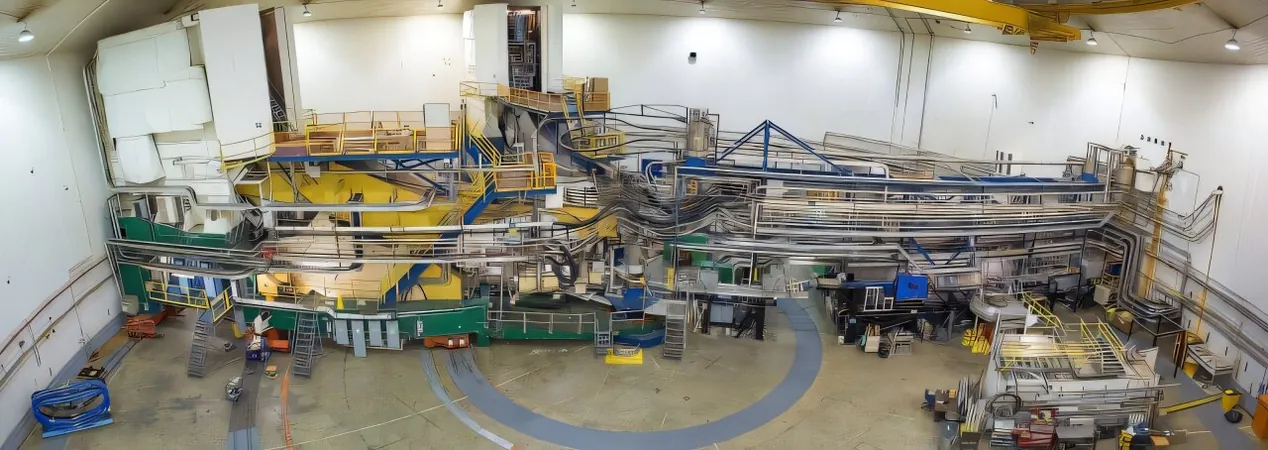
Unlocking the Secrets of Nuclear Interactions: A Breakthrough in Three-Nucleon Studies
2025-07-31
Author: Arjun
A Dynamic Dance of Nucleons
When we picture atomic nuclei, we often see a static assembly of protons and neutrons, but in reality, these nucleons engage in a continuous, dynamic exchange of momentum. At times, they interact through the strong force, temporarily pairing up and forming high-momentum nucleon pairs that drive short-range correlations.
Groundbreaking Research at Jefferson Lab
Exciting developments have emerged from experiments at the U.S. Department of Energy's Thomas Jefferson National Accelerator Facility. Researchers are delving deep into these short-distance interactions, particularly focusing on three-nucleon correlations, which had not been previously detected.
New Findings in Quantum Physics
Published in Physics Letters B, this innovative study leverages data from a 2018 experiment to explore these elusive three-nucleon interactions. Physicists are adamant that understanding these interactions is crucial for piecing together the complete picture of nucleon momentum distribution in atomic nuclei.
"We’re unraveling the nucleus to identify gaps in our knowledge," stated John Arrington, a prominent scientist at Lawrence Berkeley National Laboratory. This study marks the first time researchers have come close to observing this vital aspect of nuclear structure.
Simplifying the Search with Mirror Nuclei
Conducted at Jefferson Lab's Continuous Electron Beam Accelerator Facility, the experiment employed high-energy electron beams aimed at light nuclear targets—specifically helium-3 and tritium, known as mirror nuclei due to their complementary compositions.
The unique structure of these light nuclei, each containing just three nucleons, enables researchers to pinpoint interactions during electron scattering without the confusion that arises in heavier elements.
Safety First: Navigating Research with Tritium
The team utilized tritium, a radioactive hydrogen isotope, requiring stringent safety measures throughout the experiment. The unusual gas was carefully handled to minimize risks, showcasing Jefferson Lab's capability to conduct high-precision experiments even with hazardous materials.
From Atoms to the Cosmos
While preliminary results indicate the possible detection of three-nucleon correlations, researchers emphasize the need for further data to solidify their findings. Their goal extends towards higher energy experiments at Jefferson Lab to explore the mechanisms behind these interactions.
Discovering how these high-momentum nucleons relate to neutron stars, whose dense interiors share characteristics with nuclear interactions, adds a thrilling dimension to their work. As Arrington aptly puts it, "Studying three-nucleon correlations in the lab is a much easier endeavor than unraveling their mysteries in distant neutron stars."
A Frontier of Quantum Physics Awaits
The pursuit of understanding three-nucleon short-range correlations holds immense promise, not just for nuclear physics, but for comprehending cosmic phenomena. As researchers continue to push the boundaries of their experiments, they inch closer to unveiling the intricacies of matter, both in our laboratories and light-years beyond.


 Brasil (PT)
Brasil (PT)
 Canada (EN)
Canada (EN)
 Chile (ES)
Chile (ES)
 Česko (CS)
Česko (CS)
 대한민국 (KO)
대한민국 (KO)
 España (ES)
España (ES)
 France (FR)
France (FR)
 Hong Kong (EN)
Hong Kong (EN)
 Italia (IT)
Italia (IT)
 日本 (JA)
日本 (JA)
 Magyarország (HU)
Magyarország (HU)
 Norge (NO)
Norge (NO)
 Polska (PL)
Polska (PL)
 Schweiz (DE)
Schweiz (DE)
 Singapore (EN)
Singapore (EN)
 Sverige (SV)
Sverige (SV)
 Suomi (FI)
Suomi (FI)
 Türkiye (TR)
Türkiye (TR)
 الإمارات العربية المتحدة (AR)
الإمارات العربية المتحدة (AR)